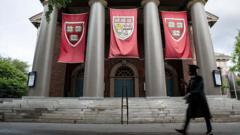After a lengthy legal struggle with a descendant, Harvard agrees to transfer significant 1850s photographs of enslaved people to a museum dedicated to Black history in South Carolina, marking a significant step in addressing America's legacy of slavery.
Harvard to Transfer Historic Photos of Enslaved People to South Carolina Museum

Harvard to Transfer Historic Photos of Enslaved People to South Carolina Museum
Harvard University will let go of historic photos depicting enslaved individuals, culminating a protracted legal dispute led by Tamara Lanier, a descendant seeking justice.
Harvard University has reached a pivotal agreement to relinquish a collection of historic photographs believed to represent some of the earliest depictions of enslaved individuals in the United States. This decision concludes a 15-year legal battle spearheaded by Tamara Lanier, a Connecticut author who claims to be a descendant of two individuals featured in the photos.
The collection, known as the Zealy Daguerreotypes, will be handed over to the International African American Museum in South Carolina, the site where the enslaved individuals lived. Harvard noted that it had always intended for these images to be placed in another museum for better contextual understanding. Lanier expressed her joy at this outcome, stating she felt "ecstatic" about the transfer.
Captured in 1850, the images are daguerreotypes, an early photography form, taken 15 years prior to the abolition of slavery via the 13th Amendment. Discovered in 1976 at Harvard's Peabody Museum of Archaeology and Ethnology, the collection comprises 15 images of individuals including Renty and Delia. The photos were commissioned by professor Louis Agassiz, who sought to substantiate his theories of racial superiority through flawed research.
This case has ignited discourse regarding how higher learning institutions should confront their historical ties to slavery. In 2016, Harvard Law School amended a shield based on the emblem of an 18th-century slaveowner in response to growing scrutiny over such issues.
While details of the settlement remain undisclosed, a university spokesperson articulated that Harvard has long desired to position the daguerreotypes within a suitable public institution to enhance access for all. Though Harvard contends it has been unable to affirm Lanier’s genealogical claims, they acknowledged the emotional distress caused by their involvement with the images, which the Massachusetts Supreme Judicial Court termed as "complicity" in a historical injustice.
Lanier shared her enthusiasm with the BBC, emphasizing her inability to preserve the daguerreotypes at the necessary level, and highlighting the deep historical connection to South Carolina. She described the forthcoming transfer as akin to a homecoming for those depicted in the images.
Tonya Matthews, president of the South Carolina museum, echoed these sentiments, promising that the images will be exhibited with sensitivity and truthfulness. She stated the mission is to facilitate dialogue surrounding the dark history of slavery and its ongoing impact today.
The collection, known as the Zealy Daguerreotypes, will be handed over to the International African American Museum in South Carolina, the site where the enslaved individuals lived. Harvard noted that it had always intended for these images to be placed in another museum for better contextual understanding. Lanier expressed her joy at this outcome, stating she felt "ecstatic" about the transfer.
Captured in 1850, the images are daguerreotypes, an early photography form, taken 15 years prior to the abolition of slavery via the 13th Amendment. Discovered in 1976 at Harvard's Peabody Museum of Archaeology and Ethnology, the collection comprises 15 images of individuals including Renty and Delia. The photos were commissioned by professor Louis Agassiz, who sought to substantiate his theories of racial superiority through flawed research.
This case has ignited discourse regarding how higher learning institutions should confront their historical ties to slavery. In 2016, Harvard Law School amended a shield based on the emblem of an 18th-century slaveowner in response to growing scrutiny over such issues.
While details of the settlement remain undisclosed, a university spokesperson articulated that Harvard has long desired to position the daguerreotypes within a suitable public institution to enhance access for all. Though Harvard contends it has been unable to affirm Lanier’s genealogical claims, they acknowledged the emotional distress caused by their involvement with the images, which the Massachusetts Supreme Judicial Court termed as "complicity" in a historical injustice.
Lanier shared her enthusiasm with the BBC, emphasizing her inability to preserve the daguerreotypes at the necessary level, and highlighting the deep historical connection to South Carolina. She described the forthcoming transfer as akin to a homecoming for those depicted in the images.
Tonya Matthews, president of the South Carolina museum, echoed these sentiments, promising that the images will be exhibited with sensitivity and truthfulness. She stated the mission is to facilitate dialogue surrounding the dark history of slavery and its ongoing impact today.




















